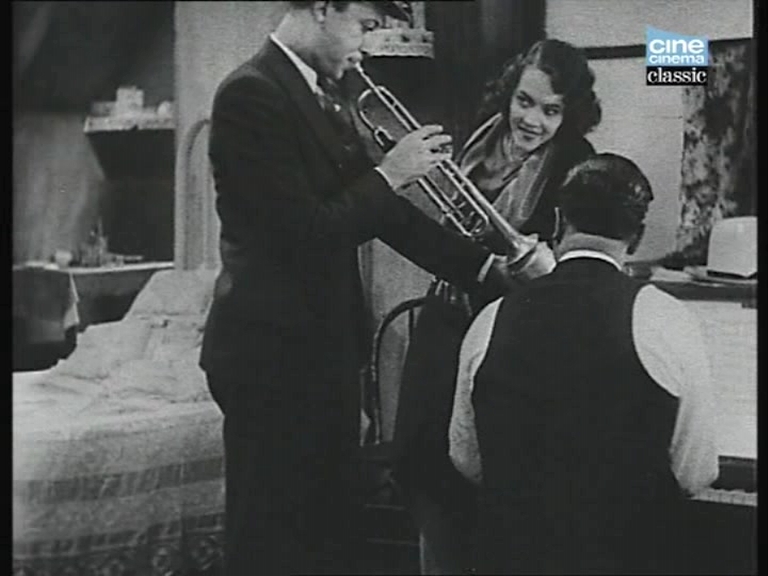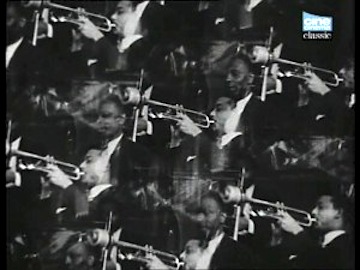Black and Tan (film)
Black and Tan Fantasy is a jazz composition by Duke Ellington and Bubber Miley in the year 1927.
On April 7, 1927, the Duke Ellington Orchestra played a the piece that won the first fame more than any other band. It reached in May 1928 # 5 on the Billboard Top 30 " It has been repeatedly singled out by former music critics and intellectuals as an example of what can be jazz. There was evidence that many of the jazz art was "noted Ellington's biographer James L. Collier. Hans Ruland keeps it with "Mood Indigo" and " Creole Rhapsody " important for Ellington's early composition.
The piece begins with a simple, yet poignant subject in a B flat minor blues pattern, presumably drafted by Bubber Miley. According to Colliers estimation, there is a variation of the New Orleans funeral marches or lamentations, which may have known Miley Sidney Bechet ago, or of King Oliver and others. After Roger Pryor Dodge Miley has his main theme of a gospel song by Stephen Adams, he heard her sing his sister. It is argued stuffed on the recording in 1927 of Miley and Tricky Sam Nanton, accompanied by tuba, banjo and clarinet sheet music stopped. Follows this twelve- issue a more complex, played by alto saxophonist Otto Hardwick. In the classic recordings followed the presentation of the topic Passage three choruses with solos by Miley (2x) and Nanton, then an arranged ensemble passage and a zwölftaktiges solo by Ellington on the piano, before the subject with allusions to Chopin's " Funeral March " ( from his second Piano Sonata ) is recapitulated. There are no drums, and the rhythm section holds back as much as possible. For Ellington, the involvement of Arthur Whetsol was particularly important in the recapitulation of the theme, because that could create at this point the audience " big fat tears."
The band played the song twice in 1927 a - for the record label Victor on October 26, and for Columbia on November 3. It was one of the most popular numbers of the band in its immediately following the Cotton Club era. Irving Mills even reports that he committed for the Cotton Club Ellington after he heard him play the piece.
The composition eventually became the basis for a short film (19 minutes), which was established in 1929 under the title Black and Tan Fantasy by director Dudley Murphy and his melodramatic frame story especially Duke Ellington and his orchestra as well as the atmosphere of the Cotton Club and its should put dancers in the scene. It premiered on 8 December 1929. In the film, the Duke Ellington Orchestra plays ( with Arthur Whetsol, Barney Bigard, Wellman Braud, Tricky Sam Nanton, but without Bubber Miley ), the title Black and Tan Fantasy, Black Beauty, The Duke Steps Out and Cotton Club Stomp. In the film, the colored (but quite fair-skinned ) actress Fredi Washington plays the lead role of a dancer, despite heart disease occurs out of love for Ellington and collapses on stage - the last thing she hears is the Black and Tan Fantasy, whose lecture by a Gospel Choir is accompanied.
Black and Tan was at the beginning of the 20th century in the United States, a designation for nightclubs and bars with musical or other entertainment especially for blacks, but they were also frequented by (cash- strong ) white audience, which was not common at the time. One example was the Exclusive Club in Harlem, where Ellington had his New York debut.
Secondary literature
- James Lincoln Collier: Duke Ellington. Berlin, Ullstein, 1999
- Hans Ruland: Duke Ellington - His life, his music, his records. Oreos, Gauting


.jpg/220px-Black_and_Tan_(still_from_opening_scene_of_film).jpg)







